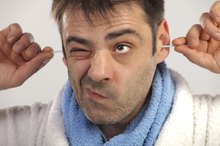Causes of Calcified Ear Wax
Venus Flytrap
Think of ear wax as the body's very own Venus flytrap. It's gross and can cause hearing problems, but it is there for a purpose. According to DoctorHoffman.com, wax, which is sticky, can capture and trap foreign entities that may fly, crawl, slip or blow into your ear, including bacteria, small insects, plant material or dirt. These entities are stopped dead in their tracks by ear wax. The purpose of ear wax is to protect the canal of your ear and your ear drum; however, if the wax is excessive, which is a problem for some people, and has been in the ear too long, it will calcify. Calcification occurs when mineral calcium builds up in soft tissue, causing it to harden.
If you are experiencing serious medical symptoms, seek emergency treatment immediately.
- Think of ear wax as the body's very own Venus flytrap.
- The purpose of ear wax is to protect the canal of your ear and your ear drum; however, if the wax is excessive, which is a problem for some people, and has been in the ear too long, it will calcify.
Hardening and Becoming Rocklike
Ear Pain After Wax Removal
Learn More
Ear wax is called cerumen, according to Teenhealthfx.com. Cerumen is created from your ears' hair follicles and glands. Everyone has ear wax, but some people have way too much. According to Otoscopes.org, this many occur because there is an overproduction of wax or there are problems regarding the natural removal and clearance of the wax. Some people may have narrow ear canals or the angle of the canal may be such that is slows down the natural passage of wax (into the outside world and onto our pillows). These are the people who suffer from wax buildup. The wax hardens (calcifies) and becomes rocklike if it has been in the ear for a long time.
- Ear wax is called cerumen, according to Teenhealthfx.com.
- According to Otoscopes.org, this many occur because there is an overproduction of wax or there are problems regarding the natural removal and clearance of the wax.
Impacted Ear
Consumerreports.org notes that a large chunk of ear wax that blocks the canal is considered impacted ear wax or an ear wax plug. It is possible for the wax to cover the ear drum, preventing you from hearing normally. This wax, which is hard, isn't easily budged.
- Consumerreports.org notes that a large chunk of ear wax that blocks the canal is considered impacted ear wax or an ear wax plug.
- It is possible for the wax to cover the ear drum, preventing you from hearing normally.
Appearance
What Causes Ear Wax Build Up?
Learn More
Fairview.org reports that fresh ear wax is yellow and soft, whereas old ear wax is black or brown and might look like blood. Old ear wax can also be flaky, white and dry. If you have coarse, wiry hairs in your ear or use a hearing aid, this may exacerbate the development of ear wax.
Wet or Dry Wax
Sometimes, ear wax is wet, and, sometimes, it is dry. When it is dry and hardens inside the ear--because it hasn't fallen out of the ear as it should have--an impaction occurs.
Irrigation
Medical professionals aren't sure why some people have problems with too much ear wax, which hardens and creates problems for the individual. However, when it becomes obstructive and impacted, it should be removed, according to Healthinfoarticles.com. This must be done carefully, because you can inadvertently shove the hardened wax further into your canal exacerbating the existing problem. You also may cause a skin abrasion inside of the ear, which can lead to infection. Irrigating the ear is the best method of getting rid of the hardened wax. A solution is put into your ear, softening the wax and allowing it to drain or to be removed. It may require a visit to the doctor's to get the impacted wax removed thoroughly and safely
- Medical professionals aren't sure why some people have problems with too much ear wax, which hardens and creates problems for the individual.
- A solution is put into your ear, softening the wax and allowing it to drain or to be removed.
Related Articles
Writer Bio
Cindi Pearce is a graduate of Ohio University, where she received her bachelor’s degree in journalism. She completed both the undergraduate and graduate courses offered by the Institute of Children’s Literature. Pearce has been writing professionally for over 30 years.








